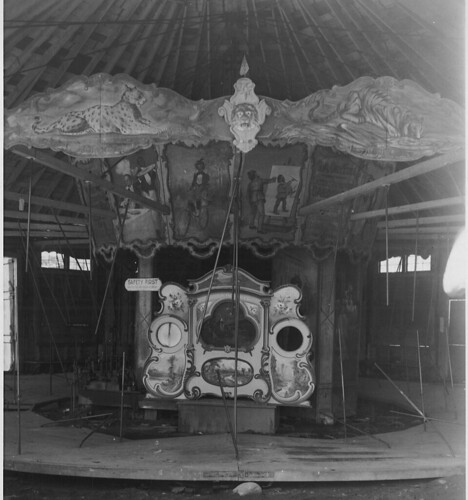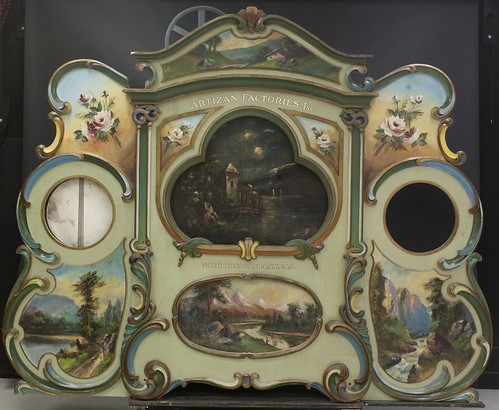 |
| The Artizan Factories A-2 band organ c. 1959 when the Dentzel carousel was being taken down |
 |
| The Artizan Factories A-2 band organ today |
This band organ came into the collection in 1961 along with the museum's Dentzel carousel, produced in 1902 for the Sacandaga Amuseument Park. Though it’s not the carousel’s original organ, it is a very rare one and appears to have had little work done to it prior to coming to Shelburne. Artizan Factories in North Tonawanda, NY only existed from 1922-1929, and many of their models that survive now have had their works replaced. This was commonly done so that organs could be made to play more current music. This one survives with its original mechanisms, one song roll, a tuning roll, and painted surfaces. It does show evidence of use, particularly oil splatter from the steam engine that powered it, but little evidence of maintenance.
Director of Preservation and Conservation Rick Kerschner wanted to see if we could get the organ working again but in a manner that would have the least impact on the original materials. With working artifacts, like musical instruments, there’s a paradox – we’d like to preserve the physical nature of the piece but we also want to hear what it sounds like, and by operating it, we’re creating wear and tear. So to get this band organ back into working order and to create guidelines for how to play it in the most responsible manner possible, we assembled a team of experts.
| John Watson (left), Bob Watters, and me having a first look at the various mechanisms from the back |
| Here's the underside of the organ. The pipes are everywhere! Bob Watters repaired two of these pipes that had broken. |
I cleaned the façade, which had been stored separately from the organ itself, cleaned the interior of the bellows and the carcass, replaced the deteriorated rubber tubing that no longer provided a proper air seal, and replaced the snares on the extant drum.
| I traced and labeled where all the tubing went before removing it. |
Here’s what it sounded like after tuning and with the snare drum in place, as Rick was troubleshooting.
Admittedly, there's more work to be done, and we're slowly working towards completion as we work on objects required for exhibitions. The organ came to the museum without a bass drum, and Tim has located a replacement for us and will be getting that to us soon. Though there’s no specific plan to display this carousel organ (yet!), we have played if for occasional public tours of the conservation lab. Keep your eyes peeled for future opportunities.
This work was undertaken, in part, with funding from the Institute for Museum and Library Services (IMLS). Thanks are also extended to scholar Fred Dahlinger for sharing his knowledge of this organ as well as the Bruder organ which was originally supplied by the Gustav Dentzel Company with the carousel they made for Sacandaga Amusement Park.






